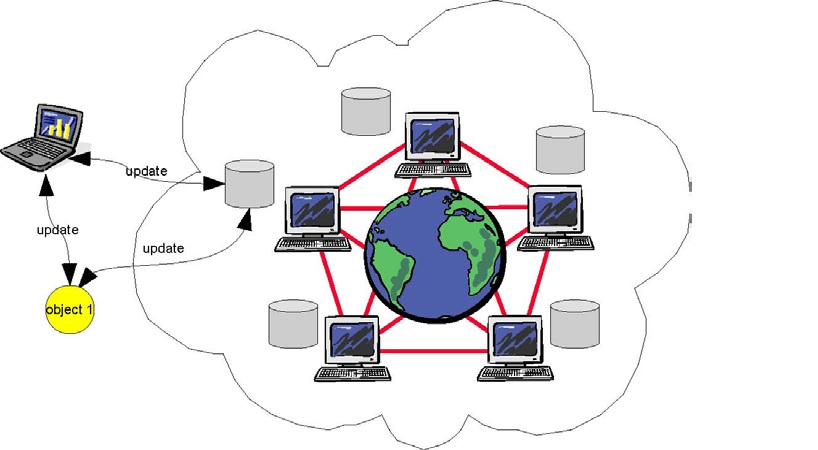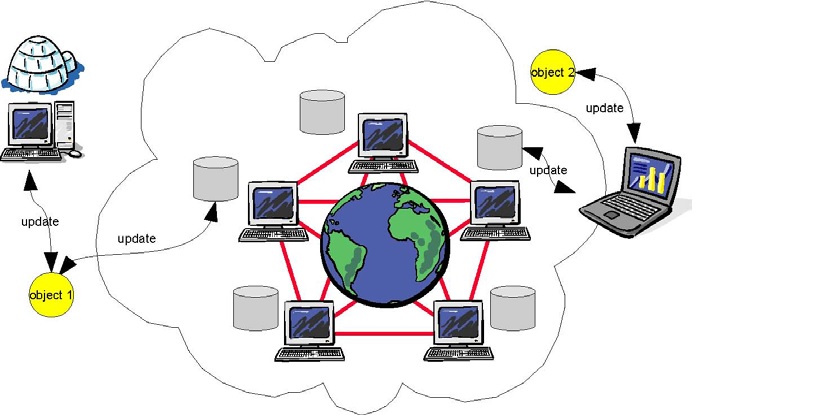Types of Network Architectures in the context of Internet of things
Data Sync
Types of Network Architectures in the context of Internet Of Things
Types of Network Architectures
Data synchronization in the context of Internet of Things depends on the availability of connectivity within the network architecture in which the objects are moving.
There are three types of architectures that have to be examined:
Connected architectures (Internet)
Partitioned architectures (Intranet, Extranet)
Disconnected architectures (local resources)
Connected Architectures
The Internet is a globally distributed network of computers carrying many services and information resources. It is assumed that resources are always connected to share and update information. Objects moving in a connected architecture do not need a special synchronization method, because object information can be updated at any place inside the network in real-time.

The EPCglobal Architecture, as a proposal for implementation of the Internet of Things supporting the logistic supply chain, is based on this connected architecture (Armenio et al. 2009). Objects may be identified by the Electronic Product Code while related information is stored in distributed repositories. Capturing and accessing object information requires a stable network connection.
Partitioned Architectures
Intranet and Extranet may be seen as types of partitioned networks. They base on the same technology as the Internet, but they are only reachable inside a closed area (Intranet) or with a special authentication (Extranet). Beside partitioned networks, there are partially disconnected devices, such as mobile devices, which are disconnected while updating object information (e.g., for maintenance). Data will be updated at the mobile device first and has to be synchronized to related network information resources when the mobile device will be connected again. Synchronization is similar to those supporting objects moving between partitioned networks. But there is a new complexity, because a mobile object may be connected to the network before data is synchronised between the mobile device and the network
resources.

Objects moving in partitioned networks may act the same way as objects inside the Internet: Objects move within the physical world while information is generated and exchanged within information networks. Information about an object might be generated while it has no reliable network connectivity (e.g. accumulation of sensor data). Therefore, it is necessary to have a robust mechanism to synchronize such information updates to the network when connectivity is available, in order that the data can be available within a single company and also shareable with other organisations.
Other challenges for data synchronisation to be considered, are synchronising data (e.g., configuration instructions) from the network toan object that only has intermittent connectivity, or interpreting the current ‘state’ of an object correctly, when some of the event information that should contribute to the state of determination arrives late, out of sequence, or not at all.
Disconnected Architectures
Many things that interact with the Internet of Things may not have permanent reliable connectivity to communication networks. This may be caused by missing technical resources (e.g., in remote areas) as well as technical restrictions that may not allow Internet connectivity (e.g., in dangerous production areas). Nevertheless, there might be objects that have to be maintained inside such areas. Those things would need information about their life cycle without having permanent reliable Internet connectivity. By contrast to their special needs, many of today’s Internet based applications require a stable network infrastructure and routinely store object information into networked repositories.
A permanent disconnected architecture has to distinguish between objects and other resources without network availability. Objects may be disconnected, because they are unmovable or only moving in environments without network availability. Mobile devices could be used to exchange information between disconnected objects and other network resources. In the case of disconnected applications or repositories, information could be exchanged via mobile objects. Both cases are shown below.

This material has been an excerpt of the book “Architecting the Internet of Things” by “Dieter Uckelman” and “Mark Harrison”.
For more information on implementing IOT in your factory email to contact@etmautomation.com or call +91 9158279000
